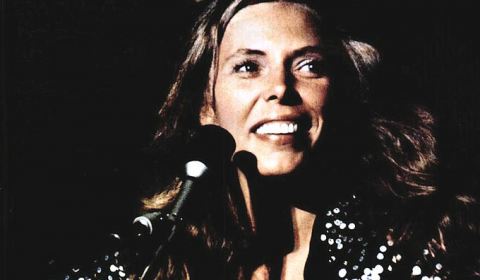Image by Asylum Records (Billboard page 2) [Public domain], via Wikimedia Commons
Michael Stipe has a teaching gig at NYU. Lynda Barry has one at UW-Madison. Sun Ra gave a classic lecture at UC-Berkeley. So why can’t we imagine Joni Mitchell landing a job at a university too? That’s what Jedidiah Anderson did, when he wrote a satirical piece over at McSweeney’s called “Joni Mitchell Applies for a Tenure Track Philosophy Position.” It begins:
Dear Search Committee:
I am applying for the position of Assistant Professor in Philosophy. I am an advanced doctoral candidate in Philosophy (with minors in Urban Studies and English), and expect to defend my dissertation in May, 2015.
My dissertation, Both Sides Now applies a bilateral, hylomorphic analysis to the phenomenon that is described by the signifier “clouds.” Having been constituted in Western discourse both positively as “rows and flows of angel hair,” “ice cream castles in the air,” “feather canyons everywhere,” and negatively as objects that exist solely to obscure the sun, express rain and snow, and hinder the achievement of various goals, we can conclude that after the application of this bilateral, hylomorphic analysis that due to these contradictory “up” and “down” epistemologies of cloud tropes, the reality of clouds is somehow still understudied, having been ignored in favor of their Platonic form/sign, and that we really don’t “know” clouds at all.
You can read the rest of her “application” here and then spend the evening dreaming about taking Joni’s classes on Plato, Existentialism, and Urban Development. I know I will.
You can find more great Joni Mitchell material below.
Related Content:
Vintage Video of Joni Mitchell Performing in 1965 — Before She Was Even Named Joni Mitchell
James Taylor and Joni Mitchell, Live and Together (1970)
The Music, Art, and Life of Joni Mitchell Presented in a Superb 2003 Documentary
Free Online Philosophy Courses


